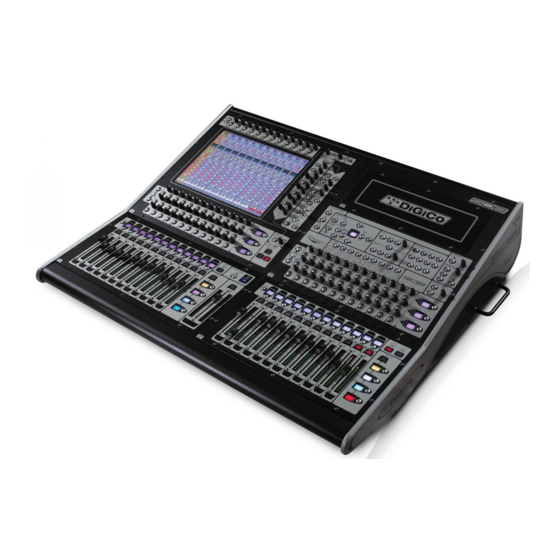digico SD10 사용자 설명서 - 페이지 20
{카테고리_이름} digico SD10에 대한 사용자 설명서을 온라인으로 검색하거나 PDF를 다운로드하세요. digico SD10 20 페이지. Replacing and cleaning faders
digico SD10에 대해서도 마찬가지입니다: 매뉴얼 (9 페이지)

Chapter 1 - Getting Started
Standard MADI Connections
If you have a standard MADI connection (not a DiGiCo Rack) to your SD10, you can set the SD10 to display the MADI with generic
signal names, i.e. MADI 1, MADI 2.. etc. through to MADI 56 instead of the usual rack style names. The naming does not affect the
signal, but makes routing signals easier.
Select the port to be configured
Auto Conforming for all ports,
individual racks,
or individual cards
Console to Console routing
If two DiGiCo consoles are connected together, it is possible to route audio between them.
Splits & Sharing
In a multi-console system where Racks are connected with MADI and shared between two DiGiCo Consoles, only one of the
consoles can take control of the rack, with respect to Gain, Phantom Power and Pads. To overcome this, it is possible to place the
SD10 into one of 3 states of operation; Isolate, Receive Only or Full Control.
Sharing is configured in the bottom right-hand corner of the window when the Splits & Sharing button is selected:
These three states can be set individually in the right column), on a per-rack basis (middle column), or globally for all shared racks
(left column).
Isolate : The SD10 will not communicate with the rack and therefore any adjustment of input gain or +48V switch will have no
effect on the rack settings
Receive Only : The SD10 will receive the rack's existing settings but will not be able to control the gain etc on the racks.
Full Control : The SD10 will send its settings to the racks and change them accordingly.
1-12
Edit the Port Name here.
Eg. Stage Rack, Local Rack etc...
Select the contents of the bottom-right
corner of the Audio IO window
Select Card Type manually or
using Auto-Conform function,
and edit Group Name
Analogue Line Out
Socket with -10db Pad
Selected Socket Properties
Edit Name and Socket options.
